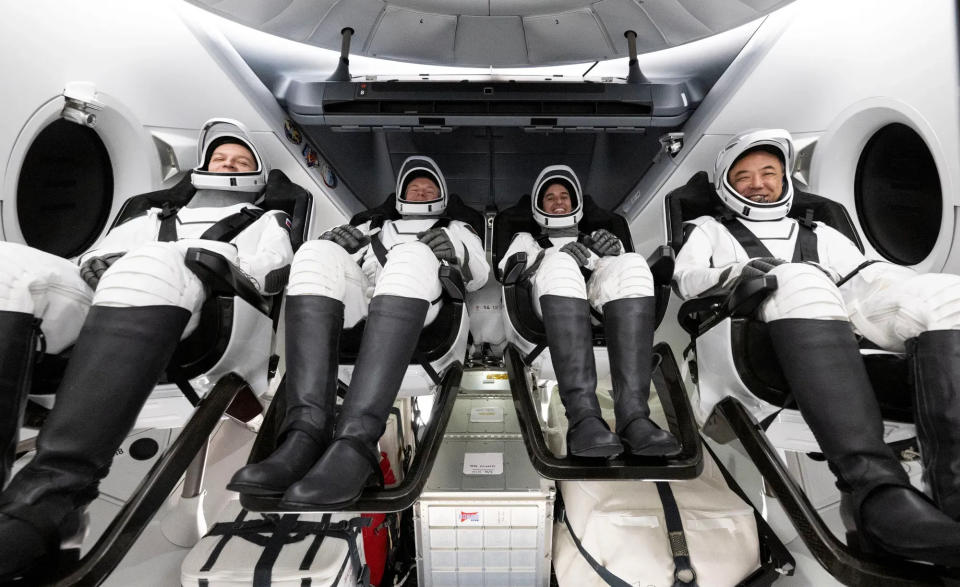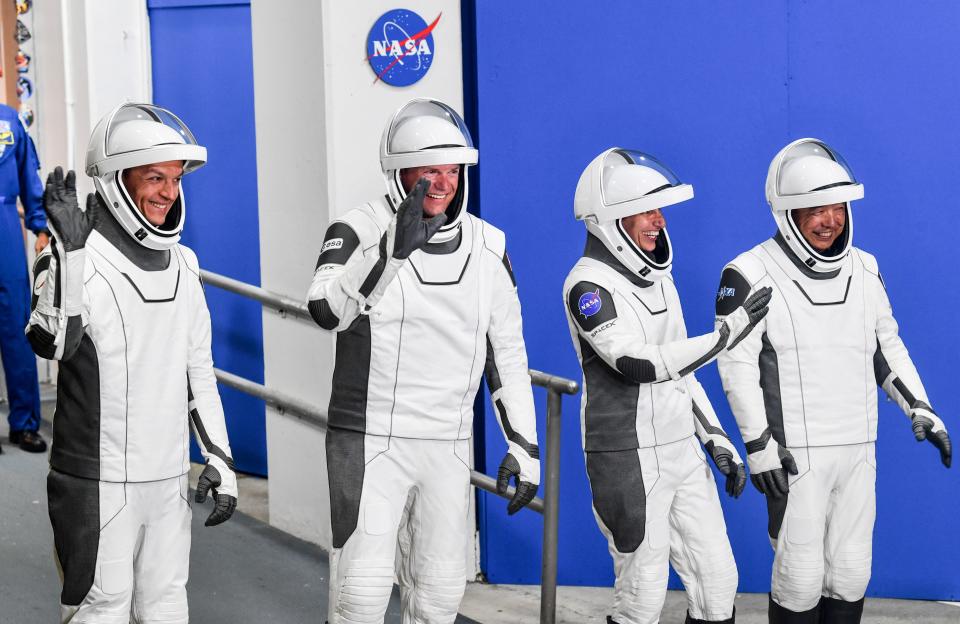NASA's Crew-7 returns to Earth in SpaceX Dragon from ISS mission 'benefitting humanity'
- Oops!Something went wrong.Please try again later.
An international crew of spacefarers has safely returned to Earth in the SpaceX Dragon Endurance after spending nearly six months aboard the International Space Station readying NASA for deep-space missions ahead of its impending return to the moon.
The four people who were part of the NASA-funded Crew-7 mission made a fiery landing Tuesday morning when they splashed down in the Gulf of Mexico off the coast of Pensacola, Florida. Following the spacecraft's landing at 5:47 a.m. ET, a recovery vessel transported the crew to shore before they were to be flown to NASA’s Johnson Space Center in Houston, the space agency said.
Following this morning's successful splashdown and recovery of #Crew7 and its Dragon spacecraft, listen in to our live return-to-Earth telecon update with experts from NASA and our partners: https://t.co/r26SkNucM0 pic.twitter.com/5iRyiSwO6w
— NASA (@NASA) March 12, 2024
Their return caps a 199-day mission that saw explorers from Russian, Europe, the United States and Japan launch in late August on a Falcon 9 rocket bound for the famed space station. The Crew-7 members spent their stint in low-Earth orbit contributing to a variety of science experiments, some of which were to help prepare NASA for future crewed lunar missions under its Artemis program as it sets the stage for expeditions to Mars.
One of the crew's members, NASA astronaut Jasmin Moghbeli, was even part of a rare all-female spacewalk.
Total solar eclipse: With one month to go, here's everything to know about the total solar eclipse on April 8
Who was part of SpaceX Crew-7?

Moghbeli was the sole American who was part of the four-member Crew-7 who launched Aug. 26 from NASA’s Kennedy Space Center in Cape Canaveral, Florida.
Also part of the crew were Roscosmos cosmonaut Konstantin Borisov, Danish astronaut Andreas Mogensen with the European Space Agency, and Japan Aerospace Exploration Agency (JAXA) astronaut Satoshi Furukawa.
It took the crew about 30 hours after lift-off to dock to the International Space Station's Harmony module’s port.
During the course of their stay, the four spacefarers traveled more than 84.4 million miles, completing 3,184 orbits around Earth, NASA said. While Mogensen has now logged 209 days in space in two flights and Furukawa has logged 366 days, the mission marked the first spaceflight for Moghbeli and Borisov.
The Crew-7 flight was part of NASA’s commercial crew program in which the space agency is partnering with private companies like SpaceX to ferry trained astronauts to the space station for scientific missions. The eighth crew comprised of three NASA astronauts and one cosmonaut launched March 3 and docked March 5 just days before their predecessors prepared to depart on Monday.
The partnership with private industry is meant to free up NASA to focus on building spacecrafts and rockets for deep space missions.
"This international crew showed that space unites us all," NASA Administrator Bill Nelson said in a statement. "It’s clear that we can do more – we can learn more – when we work together."
What did the crew do aboard the International Space Station?

The crew were able to conduct hundreds of experiments during the science and research mission, including the first study of the human response to different spaceflight durations.
They also experimented with growing food on the space station, a critical capability needed for future deep-space flights and long-term crewed missions, NASA said.
In November, Moghbeli conducted a spacewalk with fellow NASA astronaut Loral O’Hara, making for a rare moment when two women exited the station to complete maintenance activities in the void of space. Together, the astronauts replaced one of the 12 trundle bearing assemblies on a solar alpha rotary joint, which allows them to rotate properly and generate electricity to power the orbital complex.
As NASA eyes future crewed missions to the moon and beyond, Nelson said the experiments will contribute to the knowledge needed to send humans into the cosmos.
If NASA is able to launch its delayed Artemis II mission to circumnavigate the moon by the projected end of 2025, it would make for the first crewed lunar mission since the space agency's Apollo program came to an end in 1972. Ultimately, the U.S. agency hopes to send astronauts back to the lunar surface itself in 2026 for Artemis III to establish a base of operations ahead of trips to Mars.
"The science experiments conducted during their time in space will help prepare for NASA’s bold missions at the moon, Mars, and beyond," Nelson said, "all while benefitting humanity here on Earth.”
Eric Lagatta covers breaking and trending news for USA TODAY. Reach him at elagatta@gannett.com
This article originally appeared on USA TODAY: SpaceX Dragon splashes down during reentry, Crew-7 returns to Earth

